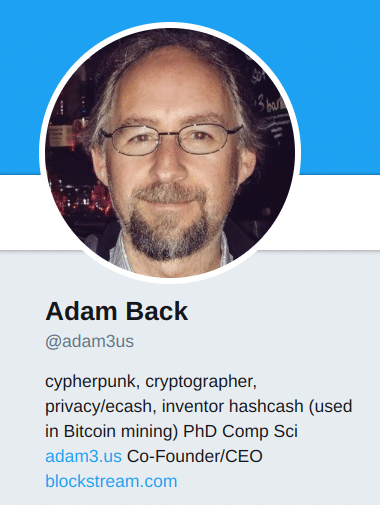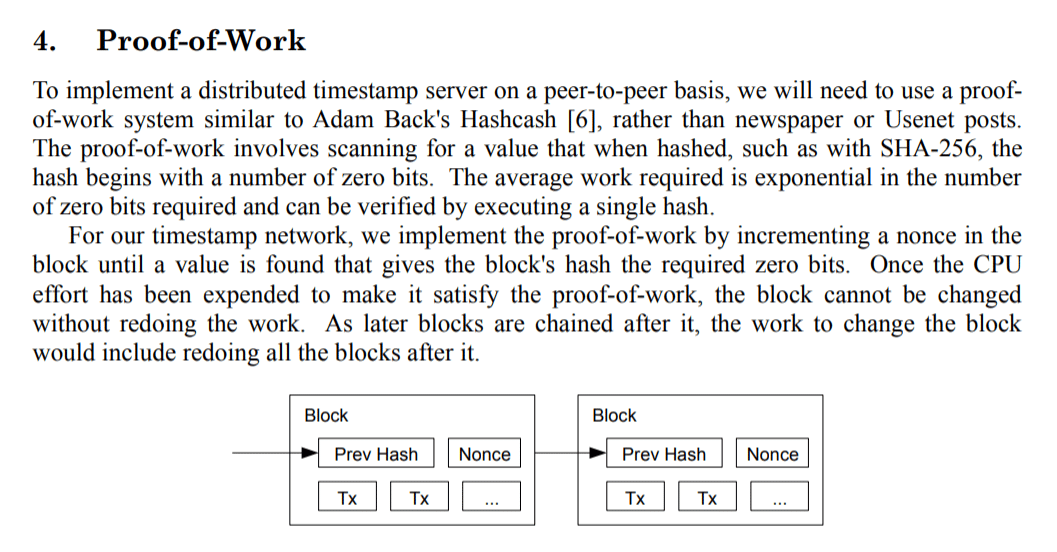- Who is Adam Back?
- Early Days
- Talking to Satoshi & Getting Cited in Bitcoin White Paper
- Starting Blockstream
- Too Much Power?
- Conclusion
Who is Adam Back?
For crypto-enthusiasts, the Bitcoin white paper has become the stuff of legend. In it, Satoshi Nakamoto outlined the concept of a blockchain and launched a revolution in the way data gets stored and transacted. While Satoshi’s identity remains obscure, the white paper does mention another name of a very real person: Adam Back. Satoshi cites Back, and the Hashcash protocol Back invented, as early influences on Bitcoin’s proof of work algorithm.
Back is a well-known British computer scientist and cryptographer. Since 2014, he has been the CEO of Blockstream, a leading Bitcoin development company that employs many of the Bitcoin Core development team. Both historically and currently, Back is an important figure in crypto, but most people don’t know much about him. This article gives a brief introduction to Adam Back and the role he’s played in the cryptocurrency space.
Early Days
Adam Back’s early career, in the 1990s, focused on the intersection of cryptography and computer science. Back earned a Ph.D. in computer science from the University of Exeter. His early work on privacy and encryption came while working at a company called Zero Knowledge Systems. While there, Back worked as a consultant to Nokia on the feasibility of using electronic cash for mobile phones.
In 1997, Back developed the idea and wrote the code for Hashcash. Hashcash is an early application of proof-of-work that makes it difficult for spammers to send millions of emails. The Hashcash protocol required the sender to compute a valid header for the email message before sending. This proof-of-work computation was simple and required less than a minute for the sender’s computer, not enough to inconvenience anyone. However, for spammers who relied on sending millions of emails, Hashcash made spamming much more computationally expensive.
Researchers in the 1990s and early 2000s were thinking about digital peer-to-peer currency as well. During that time, Nick Szabo proposed Bit Gold and Back proposed his own B-money solution, both of which used computational effort to prevent double spending. However, neither was able to effectively address the problem of inflation, especially in a system that rewards users for creating new blocks and new coins.
Talking to Satoshi & Getting Cited in Bitcoin White Paper
Of course, someone (or a group of people) would soon figure out the challenge of regulating the supply and frequency of coin issuance in the Bitcoin white paper. Back’s name appeared in the white paper as the creator of Hashcash and an influence on Nakamoto’s thinking. Nakamoto reached out to Adam Back in 2009 for more information about Hashcash and his thoughts on whether the protocol could apply on a much larger and complex scale.
Back never suspected that Nakamoto was a pseudonym and never met Nakamoto in person. Although Back followed along with Bitcoin’s progress, he did not contribute to the Bitcoin source code. Still, his name appears in the white paper and he was among a small group of people who’ve actually communicated with Nakamoto.
Starting Blockstream
The idea for Blockstream, Back’s current for-profit company, came in 2013. Back believed there wasn’t enough progress being made on Bitcoin infrastructure to prepare it for enterprise use. There also wasn’t much commercial support for such work on the protocol level.
Blockstream raised a round of seed funding for $21 million in 2014, led by Reid Hoffman (co-founder of LinkedIn, early investor in Facebook, Airbnb). In their 2015 Series A funding round, Blockstream raised an additional $55 million led by Hong Kong billionaire Li Ka-Shing.
Over the past several years, Blockstream has gained momentum as a leading developer on the Bitcoin Core. They’ve hired several Bitcoin Core developers onto the Blockstream internal team. The company is Canadian based, but the team is distributed around the world. Adam Back serves as CEO, and he lives in Malta.
Blockstream was involved in the development of the Lightning Network. They’re also developing their own liquidity solution aimed at exchanges known as the Liquid Network. Additionally, Blockstream operates a satellite that broadcasts the Bitcoin blockchain down to Earth around the world.
Too Much Power?
Opinions on Blockstream, and therefore Adam Back, are mixed within the Bitcoin community. On one hand, Blockstream has ardent fans and the allegiance of many of the Chinese mining operations. On the other hand, Reddit and other social media users have few good things to say about the company. This ill will mostly comes from the debate over Bitcoin block size and attempts to grow Bitcoin’s scalability.
Former head of the Bitcoin Foundation, Gavin Andresen, argued for an increase in the block size multiple times over the past few years. He even went so far as to build an open source version of Bitcoin where the block size is increased. While much of the community is in favor of a size increase as an answer to scalability, several Bitcoin Core developers, including employees at Blockstream, have resisted implementing the change, citing computing resource concerns with larger blocks.
[thrive_leads id=’5219′]
Some have argued that Blockstream hiring many Core developers has given the company too much power. Critics claim that Bitcoin is now a centralized institution, controlled by the Blockstream development team. This is a serious allegation and a major concern if true.
Blockstream is no doubt influential, but allegations of a complete takeover are probably exaggerated. A recent analysis from WhaleCalls found that only 12% to 20% of changes to the Bitcoin source code come from Blockstream developers. While that’s significant, it’s not exactly a takeover. That said, Blockstream does like to throw its weight around, and it’s worth keeping an eye on the company and Adam Back for more developments.
Conclusion
Adam Back has a long history with Bitcoin that dates all the way back to protocols he wrote in the 1990s. He was an influence on Nakamoto, and he continues to be influential in the Bitcoin community today as the leader of Blockstream. While much of the criticism leveled at him and Blockstream has been unfair, it’s still reasonable to say his company plays a big role in Bitcoin development. With such power comes great responsibility–and internet anger.
Never Miss Another Opportunity! Get hand selected news & info from our Crypto Experts so you can make educated, informed decisions that directly affect your crypto profits. Subscribe to CoinCentral free newsletter now.












